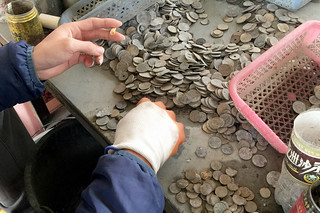
PREV ARTICLE
NEXT ARTICLE
FULL ISSUE
PREV FULL ISSUE
WSJ EXAMINES DAMAGED AND SCRAP COIN RESALE PROGRAM
An April 29, 2016 Wall Street Journal article examined the issue of damaged and scrap coins that the U.S. Mint bought back from
wholesalers until the program was recently suspended. Interesting look at an obscure business. -Editor
The U.S. ships hundreds of thousands of tons of scrap to China each year, much of it comprising the aluminum remains of broken-down vehicles that have been fed through industrial shredders. The scrap is so laden with coins, many of them battered beyond recognition, that a new industry has emerged to reclaim and repatriate them. Mr. Shahar, a 46-year-old entrepreneur, was among the first to realize the potential in pocket change more than 25 years ago. Today, he buys U.S. coins in bulk from Chinese salvage yards and exports them to his Oregon-based partner, who exchanges the coins at the U.S. Mint for a lump sum. The Mint redeems coins that are bent, burned, fused, chipped or otherwise uncountable by machine at nearly their face value, under a program established more than a century ago. The program has paid out more than $100 million since 2009, the year customs officials in Los Angeles noted a sharp increase in large coin shipments from China. The uptick was so sharp that federal law-enforcement officials have come to believe some of the dimes, quarters and half dollars arriving from the Far East are fakes. Mr. Shahar’s business was thriving until U.S. officials shut down the coin reimbursement program last year, detaining about $664,000 worth of his and his business partner’s coins, according to a lawsuit he filed earlier this year asking a judge to release them. While Mr. Shahar hasn’t been accused of wrongdoing, federal prosecutors have alleged three of his competitors imported counterfeit coins. Mr. Shahar, an Australian, said U.S. officials have simply underestimated the amount of money Americans consign to the trash heap, he said. And anyway, he said, it would be folly to make fake coins of such low value. “No one counterfeits small-value coins,” said Mr. Shahar, who lives in Israel with his wife. “It doesn’t make any economic sense.” A spokeswoman for the Justice Department declined to comment, as did a spokesman for the U.S. Mint. Mr. Shahar said he discovered the coin trade while traveling in Thailand in 1989. During a tour of a temple, the 19-year-old Mr. Shahar spotted tourists flipping coins into a wishing well. After the tour, the guide introduced him to a temple caretaker, who took him into a room filled with bags of coins sorted by country, Mr. Shahar recalled. Mr. Shahar was headed to London and planned to return to Australia, via Thailand, ina month’s time. He and the caretaker made a deal. If Mr. Shahar agreed to take 6,000 one-pound coins with him to the U.K., exchange them for cash and bring the money back to the temple, he could keep 900 pounds for himself. “I thought, ‘This is something I could do so I could finance my travels,’ ” said Mr. Shahar. He began buying coins from other temples across Asia, and then from charities, secondhand stores and metal recyclers. These days, “he has contacts all around the world,” said Adam Youngs, who imports U.S. coins from Mr. Shahar through his company, Portland Mint. Mr. Shahar said he has developed coin sources in 25 countries, but much of his business drifted to China, amid its rise as a global metal recycler—a $50 billion industry in China, according to research firm IBISWorld. Chinese recyclers sell coins retrieved from the scrap to people like Mr. Shahar for 20% to 30% less than face value, according to Mr. Shahar and others in his industry. Under the U.S. Mint’s Mutilated Coin Redemption Program, established in 1911, the government pays a standard rate of $20 per pound for mutilated dimes, quarters and half dollars. Bulk coins shipments are hauled to one of two foundries on contract with the government. They melt the metal down to be made into new coins. The Mint halted the program in November after federal prosecutors accused coin importers America Naha Inc., Wealthy Max Ltd., and XRacer Sports Co. Ltd of trying to defraud the U.S. Mint with counterfeit coins.
Obscure business, yes. But shady? What do readers make of the assertion that it wouldn't pay to make fake damaged U.S. coins for
resale? Is the goverment really underestimating the number of genuine damaged coins that could be out there? -Editor
To read the complete article, see:
To read the earlier E-Sylum article, see:
THE BOOK BAZARREWayne Homren, Editor The Numismatic Bibliomania Society is a non-profit organization promoting numismatic literature. See our web site at coinbooks.org. To submit items for publication in The E-Sylum, write to the Editor at this address: whomren@gmail.com To subscribe go to: https://my.binhost.com/lists/listinfo/esylum All Rights Reserved. NBS Home Page Contact the NBS webmaster 
|
